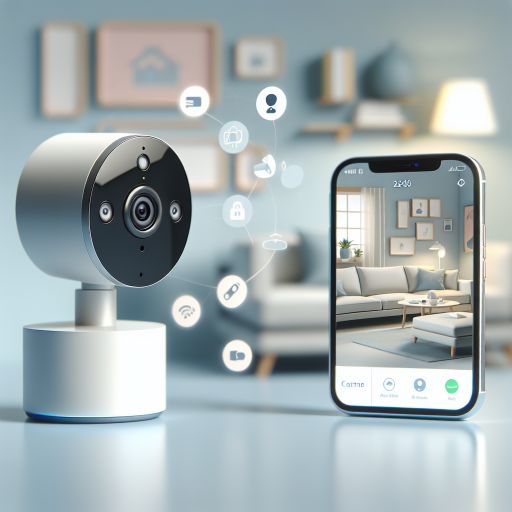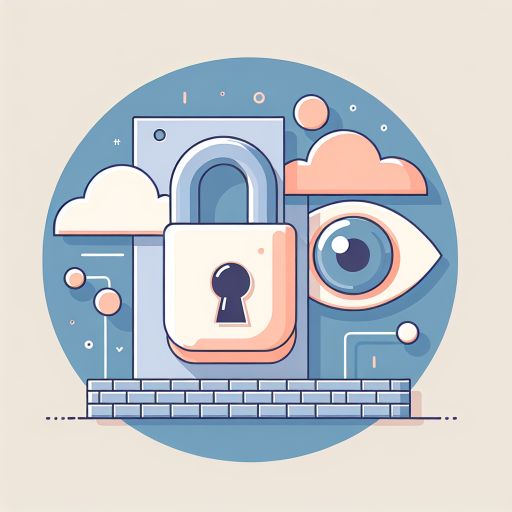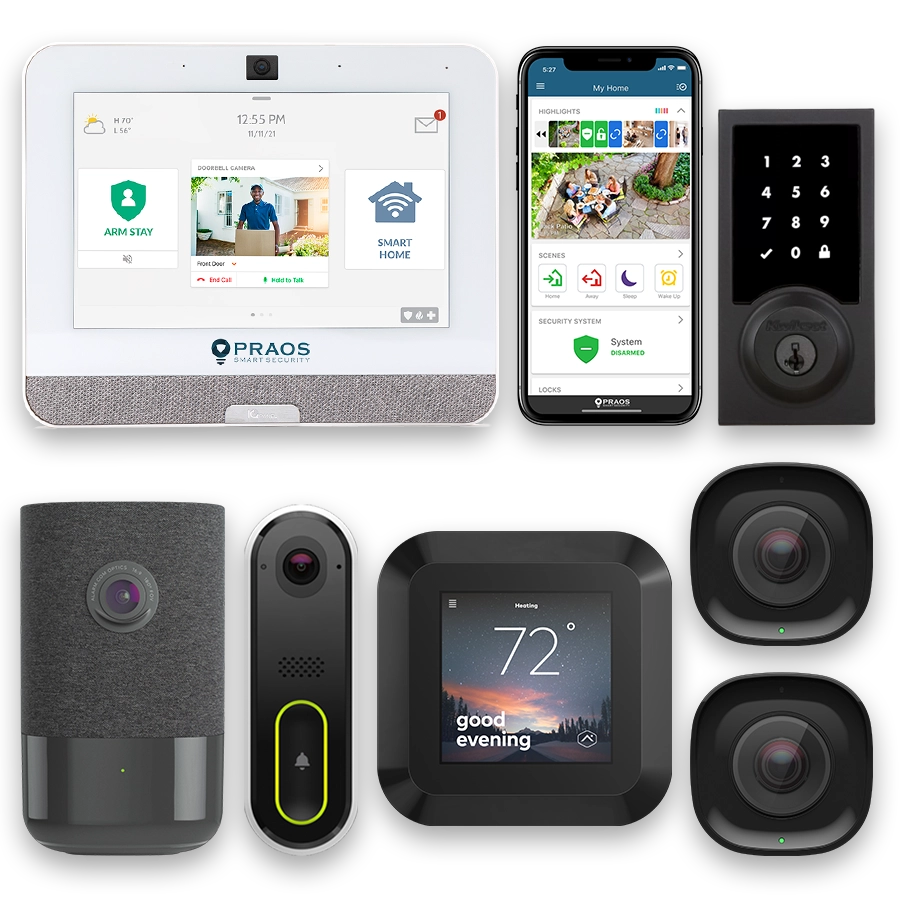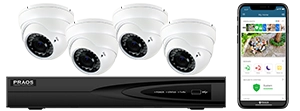Introduction to Smart Home Security Cameras
In recent years, smart home security cameras have become an essential component of modern home security. These devices offer a range of capabilities that go beyond simply capturing footage, providing homeowners with peace of mind and enhanced protection. By leveraging advancements in technology, smart home security cameras now offer various features that can deter potential intruders, provide real-time alerts, and integrate seamlessly with other smart home devices.
Smart home security cameras are equipped with high-definition resolution, night vision, and motion detection capabilities, which allow for clear and continuous monitoring of residential properties. Typically connected to home networks via Wi-Fi, these devices enable homeowners to access live feeds and recorded footage through mobile apps or web interfaces from virtually anywhere.
The market for smart home security cameras has seen significant growth over the past few years, driven by increased consumer awareness of home security and the benefits of smart home technology. According to a report by MarketsandMarkets, the global smart home market size is projected to grow from USD 78.3 billion in 2020 to USD 135.3 billion by 2025, at a Compound Annual Growth Rate (CAGR) of 11.6% during the forecast period.
Smart security cameras come in various forms including indoor, outdoor, doorbell, and wireless models, each designed to cater to different security needs and installation environments. The choice of camera depends on factors such as location, ease of installation, and specific security goals.
The following table provides a comparison of the market share for different types of smart home security cameras based on a 2022 study:
| Camera Type | Market Share (%) |
|---|---|
| Indoor Cameras | 35% |
| Outdoor Cameras | 28% |
| Doorbell Cameras | 25% |
| Wireless Cameras | 12% |
Additionally, smart home security cameras are enhanced by the integration of artificial intelligence (AI) and machine learning technologies. These advancements enable features such as facial recognition, object detection, and behavior analysis, which improve the accuracy and efficiency of security monitoring. As a result, homeowners receive more relevant and actionable alerts.
In conclusion, smart home security cameras represent a crucial development in home security, combining cutting-edge technology with enhanced usability to offer effective solutions for protecting homes. With the market continuing to expand, the availability and capabilities of these devices are likely to further improve, making them an increasingly attractive option for consumers looking to bolster their home security measures.
Key Features of Modern Smart Security Cameras

Security Cameras
Modern smart security cameras come equipped with a plethora of features designed to enhance home protection, offering users a blend of advanced technology and user-friendly functionality. This chapter explores the key features that define these contemporary devices.
High Definition (HD) and 4K Resolution
One of the most significant advances in smart security cameras is the improvement in video resolution. Many modern cameras now offer HD, 1080p, and even 4K resolution, providing much clearer and more detailed images. This level of clarity can be crucial for identifying faces, license plates, or other important details.
Night Vision
Night vision is a standard feature in many smart security cameras. These cameras use infrared (IR) technology to capture video in low-light or complete darkness. This ensures that surveillance continues unabated regardless of the time of day.
Two-Way Audio
Many modern cameras are equipped with two-way audio, allowing users to listen and speak through the camera using a smartphone app. This feature can be used to warn intruders, interact with visitors, or communicate with family members.
Motion Detection and Alerts
Smart security cameras typically integrate motion detection technology, which triggers recording and sends alerts to users when movement is detected. Advanced models can differentiate between human movement and other motion, reducing the number of false alarms.
Wireless Connectivity
Wireless cameras eliminate the need for cumbersome wiring, using Wi-Fi or other wireless protocols to transmit data. This makes installation more flexible and less intrusive, allowing cameras to be placed in a wide variety of locations.
Cloud and Local Storage Options
Storage is a critical aspect of security cameras. Many models offer cloud storage, allowing video footage to be saved and accessed remotely. Some also provide local storage options via SD cards or Network Attached Storage (NAS) devices, giving users control over where and how their data is stored.
AI and Machine Learning
Artificial intelligence (AI) and machine learning enhance smart cameras by enabling features like facial recognition, object detection, and anomaly detection. These technologies help in accurately identifying threats and reducing the number of false positives.
| Feature | Description |
|---|---|
| HD and 4K Resolution | Provides clearer and more detailed images for better identification. |
| Night Vision | Uses infrared technology to capture video in low-light or dark conditions. |
| Two-Way Audio | Enables communication through the camera using a smartphone app. |
| Motion Detection | Triggers alerts and recording when movement is detected. |
| Wireless Connectivity | Allows for flexible installation without complex wiring. |
| Cloud and Local Storage | Options for both remote and local storage of video footage. |
| AI and Machine Learning | Enables advanced features such as facial recognition and object detection. |
As these features demonstrate, modern smart security cameras are not just passive recording devices but intelligent systems designed to provide comprehensive security and peace of mind. These capabilities make them an integral part of today’s smart home ecosystems.
Top Smart Home Security Camera Systems of 2024
In 2024, several smart home security camera systems stand out due to their advanced features, reliable performance, and user-friendly integration into smart home ecosystems. The following are some of the top-rated systems available this year:
Arlo Pro 4
The Arlo Pro 4 is praised for its 2K HDR video quality, wire-free installation, and color night vision. This camera offers a 160-degree field of view, weather-resistant design, and integrated spotlight. Arlo Pro 4 also integrates seamlessly with major smart home platforms like Amazon Alexa, Google Assistant, and Apple HomeKit.
Ring Stick Up Cam Battery
The Ring Stick Up Cam Battery is known for its versatility and ease of use. It provides 1080p HD video, two-way talk, and customizable motion detection. This camera can be installed indoors or outdoors and works without the need for hardwiring. It also integrates with the Ring app for real-time alerts and monitoring.
Google Nest Cam (Battery)
The Google Nest Cam (Battery) offers high-quality video streaming and intelligent alerts. It features a 1080p HD camera with HDR, night vision, and a 130-degree field of view. The camera is battery-operated, making it easy to install anywhere, and integrates fully with the Google Home ecosystem for enhanced smart home control.
Eufy Security SoloCam E40
The Eufy Security SoloCam E40 is recognized for its affordability and local storage capabilities. This camera offers 2K resolution, AI-based human detection, and is completely wire-free. Its weatherproof design allows for both indoor and outdoor placement, and it does not require a subscription for essential features.
Wyze Cam v3
The Wyze Cam v3 is popular for its excellent value and robust features. It provides 1080p Full HD video, color night vision, and a 130-degree field of view. This camera is suitable for both indoor and outdoor use, has a compact design, and supports continuous recording with a microSD card.
Reolink Argus 3 Pro
The Reolink Argus 3 Pro combines flexibility and high performance. It features a 2K resolution, starlight night vision, and a 120-degree field of view. This camera includes a built-in spotlight and siren, and can be used with or without a Wi-Fi connection. It supports integrations with smart home systems like Google Assistant and Amazon Alexa.
These smart home security camera systems ensure a combination of excellent video quality, smart features, and ease of use, catering to various user preferences and needs in home security for 2023.
Installation and Setup of Smart Home Security Cameras
Setting up smart home security cameras can seem daunting, but with modern advancements, the process has been made relatively straightforward. This chapter delves into the essential steps and considerations for installing and setting up smart home security cameras to ensure optimal performance and security.
Preparation Steps
Before embarking on the installation process, it is crucial to carry out the following preparatory steps:
- Determine Coverage Areas: Identify key areas both inside and outside your home that require surveillance.
- Choose Camera Types: Select cameras based on specific needs, such as indoor or outdoor use, night vision, and resolution.
- Check Wi-Fi Strength: Ensure that your home’s Wi-Fi network is strong and reliable in the areas where cameras will be installed. Consider using Wi-Fi extenders if necessary.
Installation Process
Installing a smart home security camera typically involves the following steps:
- Mounting the Camera: Secure the camera in its designated spot using the provided mounting hardware. Ensure it is positioned to cover the intended area without obstructions.
- Connecting to Power: Plug in the camera to an electrical outlet if it requires power. For battery-operated cameras, ensure the batteries are charged and properly installed.
Setup via Mobile App or Web Interface
Most smart home security cameras require initial setup through a mobile app or web interface. The specific steps may vary by manufacturer, but generally include:
- Download the App: Install the camera manufacturer’s app on your smartphone or access the setup interface via a web browser.
- Create an Account: Sign up or log in to an existing account within the app.
- Add the Camera: Follow the on-screen instructions to add your camera to the app. This usually involves scanning a QR code or entering a serial number.
- Connect to Wi-Fi: Select your home’s Wi-Fi network and enter the password to connect the camera.
Table of Common Installation Elements
The following table outlines some common elements encountered during the installation process and their purpose:
| Element | Purpose |
|---|---|
| Mounting Bracket | Holds the camera in place securely on walls or ceilings |
| QR Code | Facilitates quick setup by linking the camera to the mobile app |
| Power Cable | Provides electrical power to wired cameras |
| Battery Pack | Powers battery-operated cameras, requiring periodic recharging |
Final Considerations
After installation and setup, it is important to:
- Test the System: Verify that the camera is capturing video as expected and can stream the feed to your devices.
- Adjust Settings: Customize features such as motion detection sensitivity, notification preferences, and cloud storage options.
- Secure the Network: Ensure your Wi-Fi network is secure to prevent unauthorized access. Use strong passwords and consider network segmentation for your devices.
Following these steps will help ensure that your smart home security camera system is installed correctly, and operates efficiently, providing enhanced security for your home.
Integration with Other Smart Home Devices
Smart home security camera systems are not standalone entities. Their true power emerges when they are integrated with other smart home devices. Such integration enhances convenience, broadens the scope of security, and refines the user experience.
Compatibility with Smart Assistants
Many modern smart security cameras are compatible with popular smart assistants like Amazon Alexa, Google Assistant, and Apple HomeKit. This compatibility allows users to control their cameras using voice commands. For instance, you can ask Alexa to show the live feed from a specific camera directly on your compatible smart display.
Interoperability with Security Systems
Integration with comprehensive home security systems, such as those offered by companies like ADT or Vivint, provides an added layer of protection. These systems can sync camera footage with other security measures like door sensors, motion detectors, and alarms. In case of an alert, these systems can provide a holistic view of the situation.
Smart Lighting Integration
Integrating security cameras with smart lighting systems such as Philips Hue or LIFX can enhance home security. Smart lighting can be programmed to activate when the camera detects motion, thereby potentially deterring intruders. Additionally, smart lights can provide better illumination for the camera, ensuring higher quality video footage during nighttime.
Integration with Smart Doorbells
Smart doorbells, such as those from Ring or Nest, often work in tandem with security cameras. This integration allows the doorbell to trigger recording on nearby cameras in the event of motion detection or visitors. This dual capture system can provide comprehensive coverage of the entry points to your home.
Home Automation Routines
Using platforms like IFTTT (If This Then That), users can create custom automation rules that link their security cameras with other smart devices. For example, you can set up a routine where, if your security camera detects motion, the thermostat adjusts the temperature, or the window blinds close for privacy.
Notification Systems
Integration with other smart devices enables more sophisticated notification systems. Instead of just receiving a standard alert, your smart home system can activate specific actions. For example, you can receive notifications on your smart TV or have an alert sounded through your smart speakers.
By integrating smart home security cameras with existing and new smart home devices, homeowners can create a more interactive and secure living environment. This interconnected ecosystem provides a seamless and enhanced security experience.
Privacy and Security Concerns
The proliferation of smart home security cameras has brought significant advancements in home protection, but it has also raised substantial privacy and security concerns. These concerns primarily revolve around data security, unauthorized access, the potential for information misuse, and overall system vulnerabilities.
Data Security: One of the primary concerns is the security of data captured and stored by smart home security cameras. These devices record and transmit video footage, often storing it in the cloud. Ensuring this data is encrypted during transmission and while stored is crucial to prevent unauthorized access.
Encryption is a critical feature that users should look for when selecting a smart home security camera. It ensures that the data remains unreadable to anyone who does not have the proper decryption key. Many leading brands use advanced encryption standards, such as AES-256, to protect user data.
Unauthorized Access: The risk of unauthorized access to smart home security cameras is another significant issue. Hackers may exploit vulnerabilities in the camera’s software to gain control, potentially accessing live feeds or stored footage.
Two-factor authentication (2FA) can add an extra layer of security by requiring not just a password but also a second form of verification, such as a code sent to the user’s mobile device. Implementing strong, unique passwords and regularly updating them can also mitigate the risk of unauthorized access.
Information Misuse: Another concern is how the data collected by smart home security cameras is used. Companies may collect more data than necessary and use it for purposes beyond home security, such as targeted advertising.
Users should review the privacy policy of the smart home security camera provider to understand what data is collected, how it is used, and with whom it is shared. Opting for companies with transparent practices and strong privacy commitments can reduce the risk of information misuse.
System Vulnerabilities: The interconnected nature of smart home security systems means that vulnerabilities in one device could potentially compromise the entire network. Ensuring that all devices, including routers and other smart home equipment, have the latest security updates is essential.
Regularly updating the firmware of smart home security cameras can prevent known vulnerabilities from being exploited. Users should enable automatic updates when possible to ensure they receive the latest security patches as they become available.
To address these privacy and security concerns, consumers are advised to choose reputable brands that prioritize security features, maintain rigorous data protection policies, and offer robust customer support. Being proactive in following best practices for data security can significantly enhance the protection afforded by smart home security camera systems.
Consumer Trends and Market Analysis for 2023
According to recent market research, the smart home security camera industry has experienced significant growth in 2023. One of the primary drivers of this increase is the rising consumer awareness of home security needs. Moreover, the advancements in technology have made smart cameras more accessible and efficient.
The demand for smart home security cameras is also influenced by the increasing rate of urbanization and the need for enhanced security in residential areas. Consumers are increasingly seeking comprehensive security solutions that not only offer high-resolution video capture but also incorporate features such as facial recognition, real-time alerts, and integration with other smart devices.
Key Consumer Preferences
Current consumer preferences in 2023 indicate a trend towards security camera systems that offer a balance between cost, features, and ease of use. Several critical factors influencing purchasing decisions include:
- Image Quality: There is a strong preference for cameras that provide high-definition (HD) or even 4K resolution to ensure clear and detailed surveillance footage.
- Smart Features: Consumers favor cameras equipped with AI-driven capabilities such as motion detection, person detection, and customizable notifications.
- Seamless Integration: The ability to integrate security cameras with existing smart home ecosystems, including virtual assistants like Amazon Alexa and Google Assistant, is highly valued.
- User-Friendly Interfaces: Consumers prefer systems with intuitive mobile apps and, web interfaces that allow for easy monitoring and control.
Market Leaders
The competitive landscape of the smart home security camera market in 2023 is dominated by several key players. Brands such as Arlo, Ring, Nest, and Eufy continue to lead due to their robust product offerings and strong consumer trust. They have consistently released new models that include cutting-edge features and improvements based on customer feedback.
Growth Projections
Industry experts predict continued growth in the smart home security camera market, with a compound annual growth rate (CAGR) expected to remain in the double digits over the next five years. This growth is attributed to several factors:
- Increasing adoption of smart home devices globally.
- Ongoing technological advancements making smart cameras more affordable and feature-rich.
- Growing consumer concerns over safety and security.
- Government regulations and incentives for home security solutions in certain regions.
Overall, the consumer trends and market analysis for 2023 suggest a vibrant and expanding market for smart home security cameras, driven by evolving technology and heightened consumer demand for enhanced home protection.
Future Developments in Smart Home Security Technology
The realm of smart home security technology is continually evolving, driven by advancements in artificial intelligence, machine learning, and connectivity. As we look to the future, several key developments are poised to shape the next generation of smart home security camera systems.
Artificial Intelligence and Machine Learning
Artificial intelligence (AI) and machine learning (ML) are becoming increasingly integral to the functionality of smart home security cameras. These technologies enable cameras to perform more advanced tasks such as facial recognition, distinguishing between humans, animals, and inanimate objects, and even predicting potential security threats based on behavioral patterns.
Improved Video Quality
Superior video quality remains a priority for future smart home security cameras. Innovations in 4K Ultra HD and potential developments in 8K resolution promise to enhance the clarity and detail captured by these systems, enabling more precise identification of individuals and incidents.
Enhanced Connectivity and Integration
The integration of smart home security cameras with other IoT devices is expected to deepen. Future systems will likely feature improved compatibility with diverse smart home ecosystems, allowing for seamless communication between security cameras, smart locks, lighting, and more. This enhanced connectivity will be facilitated by the roll-out of technologies such as Wi-Fi 6 and 5G, offering faster data transmission and more reliable connections.
Edge Computing
Edge computing is another area of growth, where data processing occurs directly on the camera rather than in a centralized cloud server. This development will reduce latency, enhance real-time processing capabilities, and alleviate privacy concerns associated with cloud storage.
Battery and Power Innovations
Future developments are also expected in battery life and energy efficiency. Camera systems might utilize solar power or advances in battery technology to extend operational life without frequent recharging or cumbersome wiring.
Advanced Motion Detection
Advanced motion detection algorithms will become more sophisticated, capable of ignoring irrelevant movements and focusing on genuine threats. These improvements will reduce false alarms and ensure that homeowners are alerted only to significant activities.
Voice Control Integration
Voice control through virtual assistants like Amazon Alexa, Google Assistant, and Apple Siri will become more prevalent, allowing users to manage their security systems hands-free, enhancing both convenience and accessibility.
Data Security Enhancements
With privacy being a critical concern, future developments will likely focus on enhancing data security. This includes stronger encryption protocols, secure data transmission methods, and more rigorous authentication processes to prevent unauthorized access.
The future of smart home security cameras is undoubtedly promising, with numerous technological advancements on the horizon. These innovations will provide homeowners with more effective, efficient, and secure ways to protect their homes and loved ones.





